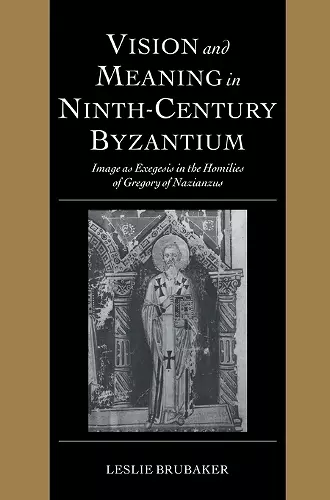Vision and Meaning in Ninth-Century Byzantium
Image as Exegesis in the Homilies of Gregory of Nazianzus
Format:Hardback
Publisher:Cambridge University Press
Published:25th Feb '99
Currently unavailable, and unfortunately no date known when it will be back
This hardback is available in another edition too:
- Paperback£46.99(9780521101813)

The Byzantines used imagery to communicate a wide range of issues. In the context of Iconoclasm - the debate about the legitimacy of religious art conducted between c. AD 730 and 843 - Byzantine authors themselves claimed that visual images could express certain ideas better than words. Vision and Meaning in Ninth-Century Byzantium deals with how such visual communication worked and examines the types of messages that pictures could convey in the aftermath of Iconoclasm. Its focus is on a deluxe manuscript commissioned around 880, a copy of the fourth-century sermons of the Cappadocian church father Gregory of Nazianzus which presented to the Emperor Basil I, founder of the Macedonian dynasty, by one of the greatest scholars Byzantium ever produced, the patriarch Photios. The manuscript was lavishly decorated with gilded initials, elaborate headpieces and a full-page miniature before each of Gregory's sermons. Forty-six of these, including over 200 distinct scenes, survive. Fewer than half however were directly inspired by the homily that they accompany. Instead most function as commentaries on the ninth-century court and carefully deconstructed both provide us with information not available from preserved written sources and perhaps more important show us how visual images communicate differently from words.
"...this first-rate study has far-reaching implications for anyone interested in religious language of images." Georgia Frank, Religious Studies Review
"Brubaker (Univ. of Birmingham, UK) has produced by far the most penetrating study of this key work." Choice
"Leslie Brubaker has written an important and illuminating book that will be required reading by all students of Byzantine art and culture. It will also be valuable for students of medieval manuscripts in general, who are interested in the ways that paintings in books can be used to construct meanings independent of their accompanying texts." Henry Maguire, Slavic Review
"No other book in the field of Byzantine art history has been as long and eagerly awaited as Leslie Brubaker's study of the Paris Gregory. She provides the perfect answer to the sometimes unfortunate trend of quickly publishing one's dissertation, the sine qua non of academic advancement. Nuanced, sophisticated, compelling, the book which resulted in this case makes dispatch in publishing the labours of a graduate career unseemly. Brubaker has provided a necessary study for any art historian concernec with the relationship between image and text in a work of art, and, especially for those freshly vindicated partisans, with the ascendancy of the visual over the textual. This book should not be distant from the desk of any medieval art historian; for this reviewer, it will be a touchstone." Word & Image
"...Vision and Meaning in Ninth-Century Byzantium will be essential for any library serving Byzantine, medieval, or art-historical studies." The Catholic Historical Review
ISBN: 9780521621533
Dimensions: 255mm x 180mm x 34mm
Weight: 1370g
568 pages